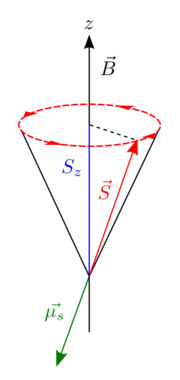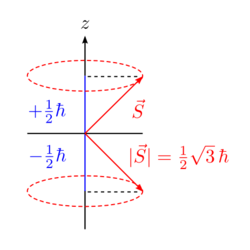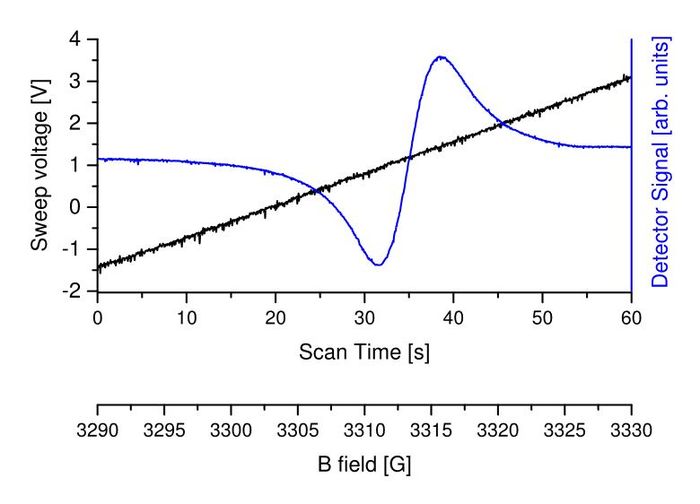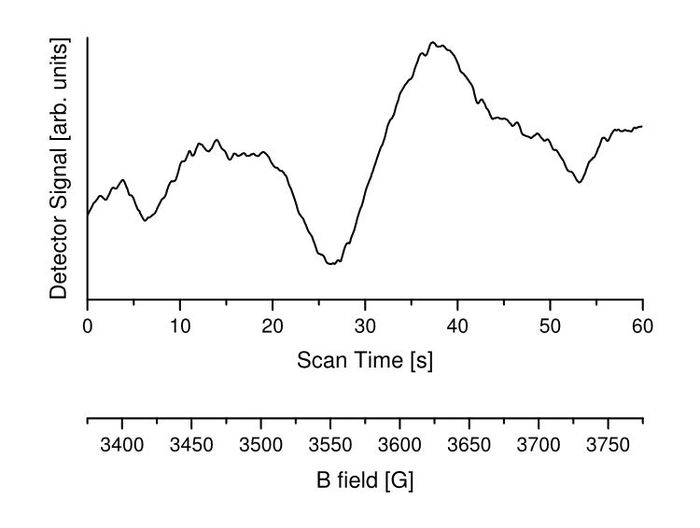Electron Spin Resonance
Electron Spin Resonance (ESR) is a phenomenon, usefull for the investigation of materials which contain unpaired spins. Those are caused by various sources. One are not completely filled atomic shells, however, the more interesting ESR signals arise from different circumstances combined in the term defect. For instance, a important one is impurities of semiconductors or isolators which can trap electron or holes. Therefore this measuring technique is very powerfull evaluation of material properties and is used in lots of research fields in physics, chemistry and biology.
Contents
Physical background
As the term Electron Spin Resonance already implies, the most essential part of the entire topic is the Spin, an intrinsic angular momentum of the electron. In an atom most of the electron are paired regarding spin. That is, each electron has a partner with an opposite spin, creating a zero net spin. Depending on the electron configuration of an atom or one step above in molecules and solids respectively, it is possible that there are a few or even many single electrons, being up to material.
Generally the magnetic moment of an electron is given by
,
where is the Bohr's magneton and the magnetogyric ratio, for a free electron it is . This quantity is a measure for the quantitive relation of an angular momentum and its corresponding magnetic momentum. The latter formula includes the orbital angular momentum as well. With ESR it is only possible to detect and investigate the spin component of the total magnetic moment. Hence, in the further deviation we will look at the pure magnetic moment originating from the spin .
If the spin and its magnetic moment is placed in a externally applied magnetic field, the magnetic moment of the spin starts to precess around the axis of the magnetic field due to the torque
.
As always in Quantum Physics the chosen axis of the magnetic field points in direction.
In generell, the energy of a magnetic moment is defined as
.
The magnetic moment is related to the spin , which is a so called Quantum Vector with special properties:
- Absolute value:
- Projection onto the z-axis:
Incedentally, those two quantities are the best way to distinguish the state of the electron, because only their operator commute and hence, are mesasurable at the same time. For instance, it is not possible to measure two of the three cartesian components of the spin vector simultaneously.
The equation for the energy of the electron's spin in an applied magnetic field contains a dot product between the magnetic moment and the B-field:
It may seem to complicate the situation, but acutally it simplifies it a lot. We have chosen our magnetic field to point into the direction. Since the spin is characterized by the projection onto the axis, depicted by the Quantum number , the dot product cancels to
with
.
Bohr's magneton and the magnetogyric ratio are both natural constants at this point. If a external magnetic field is applied (positive value, because we picked the orientation of our coordinate system in such a way), the electron's energy is reduced or raised, depending whether is negative or positive, respectively. The original single energy state, which we still get out of the equation for , is split into two different energy states. Moreover, the energy difference
is proportional to the strength of the applied magnetic field. Therefore that difference can be tuned very precisely by the experimental setup, which is very important for the latter detection of the ESR signal.
For typical laboratory B-fields the energy difference ranges in the microwave photon band, if you convert the energy to wavelength or rather frequency. This is the point, where the name of the entire phenomenon originates. Namely, if one irradiates the unpaired spin, which normally sits in the lower energy state (due to general energy minimization of nature), with the correct frequency, the energy gets absorbed, combined with a transition to the upper level. In this case, the energy of the photons match exactly the energy difference between both states. Physicist call this situation Electron Spin Resonance.
In formula language the following becomes true:
,
where is Planck's constant and the frequency of the incident light.
Other than the magnetogyric ratio are all quantities either natural constants or measured values. Above I claimed that this value is a natural constant, too. Well, technically it is one, however, depends on the material and its compounds and especially spin stucture. Taking the previous equation as well as transferring it to an expression for the magnetogyric ratio
yields material properties with regard to the spin configuration. For example, the comparison to the definite value of a free electron is an good indicator for various substances' features.
Experimental setup
Operating instructions
ESR measurements
We have a bunch of samples, which are supposed to be responsive to ESR. Unfortunatly none of them, except two, are labeled or named. In the entire process of working on this project we tested numerous samples of this set. Most of them did not show any signal within the whole magnetic field scan range, however, at this point our skills on at which dial to chose which value was really limited. We tried to tune and optimize the quantities though, and dedicated quite a lot of time to consistency and the attempt to repeat ESR spectra with different materials.
DPPH
The strongest signal shows DPPH, the organic chemical compound 2,2-diphenyl-1-picrylhydrazyl. The absorbance of the indicent microwave irradiation is really strong, such that the various parameters of the entire experiment loose their importance. As long as reasonable values for the numerous setting are chosen, one can find the strength of the magnetic field, where the dip in the by the cavity reflected power occurs - even when the magnetic field gets scanned kind of fast. Therefore, it's the perfect sample for the beginning and for ESR learners, because you receive a response for regulations far off the optimum. Moreover, always when something is changed at the experimental setup and it seems that it does not work appropriatly any more, it is the sample to varify any issues, misalignment and damage.
One of our nicest DPPH spectrum is shown below. The figure depicts the linear sweep of the magnetic field strength as well, related to the sweep voltage:
This spectrum is taken with the original main console as central controlling panel (future plans are to bypass this entire part) and the digital oscilloscope on the laptop, using the data aquisition board from Measurement Computing. The concrete set values are
- Frequency (exterior wavecounter): 9.2437 GHz
- Attenuation: 20 dB
- Iris (rotation from closed completely): 3.75
- B field start: 3290 G
- B delta: 40 G
- Scan time: 1 min
- Signal filger: position 7
- Modulation amplitude: 4
- Gain: 1000
Incidently, the sweep voltage is very important to find the acutal start and end point of the sweep at this stage, because it is directly coupled to the mechanical sweep mechanism. One can use the trigger, but there is still a delay between the impulse and the real start of cycle.
ZnS
In fact this sample not only contains ZnS, but it form a layer on a Silicon wafer. Since Silicon forms a perfect lattice, in theory, all that is observed ESR respond should originate from the ZnS coat. Though, everybody knows that practically there are no perfect crystalls in nature. Hence, it is possible that signals arise as well from impurities in the Silicon lattice.
In fact, the exact magnetic field strength of this sample, we found by first looking up, where it should appear approximately. It is much weaker and therefore the influence of the experiment parameters are much more sensitive. If you are off the right setting by quite a lot, you will not obtain a clear spectrum. And due to the constant self-evolvement of the old setup, which was build, with all liklyhood, decads ago, it is really tough to repeat one beautiful right away.
After a long fight with the experiment setup and plenty of praying we finally could measure a very nice spectrum of ZnS, how it is supposed to be:






























